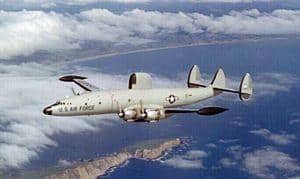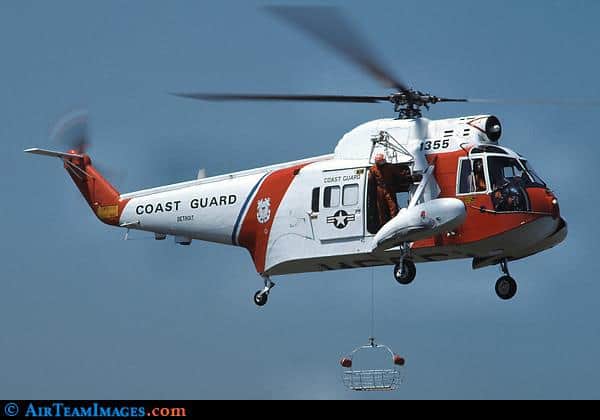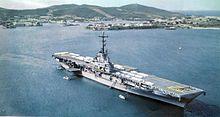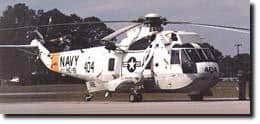Who can’t find an aircraft carrier?
I had seen every John Wayne movie about WWII, and all the naval movies plus newsreels and stories about air battles and aircraft. In every one that showed an aircraft carrier there was always a big wake streaming from the stern with the bubbling, turbulent water that could be seen for miles.
That isn’t necessarily real life. Let me tell you about my experience some 140 mile east of Otis Air Force Base on Cape Cod, Massachusetts.
It was a typical night at USCG Air Station Salem, Massachusetts located about 15 miles NNE of Boston. It was Sunday July 11, 1965 and I was the duty helicopter pilot for our stalwart HH-52 helicopter.
We received a call from the Rescue Coordination Center (RCC) that evening about an Air Force C-121 who was on a radar barrier patrol over the Atlantic Ocean, was having difficulties, and was going to ditch in the water about 140 miles east of Cape Cod.

Reports regarding the C-121 were that of the four engines powering the aircraft one engine was feathered (stopped), and another engine was on fire.
With those problems the aircraft was going to land in the water.
Off we went in HH-52 #1359 to refuel and stage out of Otis Air Force Base located on Cape Cod. Myself, the copilot (whose name I cannot remember) and one crewman. We made it to Otis without incident, refueled and were ready to go help our fellow airmen in distress. The fact that it was very dark and visibility on scene was being measured in feet instead of portions of a mile was no deterrent. Somebody needed help.

No matter how I tried, the duty controller at RCC wasn’t letting us go. So I sent the copilot and crewman off to sleep while I stayed at Otis Operations. I probably slept a little on one of those hard bottom plastic and aluminum chairs that are so famous in such military posts, but it couldn’t have been much sleep.
Of course, there was that little matter of fuel. With the normal range of the HH-52 being 125 miles plus 20 minutes hovering before returning to land it was obvious, we would have to refuel on board some Navy ship. Venturing 140 miles over open ocean in our single engine helo navigating only by dead reckoning (DR) and with no covering air support for navigation and radio assistance was not a problem to us. Heck, we were Coast Guard aviators, and could do most anything to help someone else.
Fortunately, there were NATO maneuvers being conducted in the area of the reported crash with a large number of US Navy as well as German and other vessels scattered around. Included in the fleet was the aircraft carrier USS Wasp.
Finally, we were cleared by RCC and departed early on July 12 with a full load of fuel, a list of radio frequencies and almost zero/zero visibility in fog at the destination. We arrived in the area with the ceiling and visibility unchanged. No wind, no visibility – just fog.
The Navy cruiser with whom we contacted inbound were very professional. They had us on radar and vectored us toward a relatively clear area in the fleet to make our self-contained IFR (Instrument Flight Rules – meaning we couldn’t see anything) approach to a hover over the water. Except at the 50 feet hover we still couldn’t see the ocean. After a gentle, hovering IFR decent we were near enough to see the ocean, went visual and started our search.
After a while we found one of the crewmen floating in the water inside his fully inflated survival suit. He looked fine, but unfortunately did not survive the crash.
We contacted the cruiser to advise them of our finding, and asked them to send a boat. While hovering near the person our crewman suddenly blurts out with great emphasis and increased volume “There’s a big ship backing down on us!”
I swung the helo around 90 degrees, and sure enough this big cruiser is appearing from the fog, stern first, backing down on us. We could only see part way along the hull because of the thick fog, and it was indeed an intimidating sight. We eased away from the Cruiser and they picked up the body with one of their boats.
After continuing the search as long as we could, and with no further results, it was time to acquire some much-needed fuel. So I made an IFR climb out from the fog and contacted the air controller folks on the USS Wasp.

The air controllers made contact with my helicopter on radar, and the controllers directed my flight path to a position where I could start my instrument approach CCA (carrier-controlled approach) to the Wasp. This should be no sweat, I thought. Just get in close and I will pick up the wake of the big ship. I’d seen it dozens of times in the movies.
Unfortunately, this was no movie, and there was no heroic scripted ending. The controllers guiding me through the radar CCA approach brought me within one-quarter mile of the large aircraft carrier, and advised they had lost the helicopter’s radar signal in the radar sea return. Great! Here I am within one-quarter mile of a giant piece of floating steel; I can’t see the ship; I can’t see any wake coming from the ship; I’m running low on fuel; the ship has lost radar contact with my helicopter; I’m flying next to the water completely on instruments, and no one can see a thing outside the helo.
Still looking for the ship’s wake, and still basically flying on instruments because of no visibility and no visual reference, I cautiously eased us in, and went down to about 25 feet where I could see the water – and, hopefully, the ship’s wake. Closer and closer I was edging in, looking for the wake and/or the ship. I was essentially in a hover with no reference as to my speed or where the steel monster might be.
How can you not see an aircraft carrier, or at least its wake, when only a few hundred feet away? Nothing but grey fog, and no grey ship. Where is that white frothy wake?
I kept creeping toward where the Wasp should be until I became uncomfortable and decided it was time for a wave off. [that means turn the helicopter sharply to the port (left), and fly out of this mess so I can plan what to do next] So, I return my full attention back to the instruments and start my instrument flight departure with the addition of full power, and a climbing left turn. Just as I made the left turn, and out of the corner of my eye, I see this little bitty wake about the size an 18 foot row boat would make. That was the wake of the Wasp???
What the heck happened to the big white, frothy wake I had seen in all those movies? I guess since they were tooling around in near zero conditions, they didn’t need much speed. They weren’t going anywhere, and no movies were being made about the Wasp being in the fog, but I sure could have used the wake as an approach tool.
So, another approach is started. Same thing again. I contact the radar controllers on the USS Wasp, and they direct me to a position directly astern of the Wasp. Again, I start the controlled decent remaining on the correct glide slope, and staying on course for arrival on the Wasp.
Except this time, I really need to find the ship and get some fuel. Returning to the mainland was absolutely out of the question. The CCA radar folks once again brought me in as close as they could to the carrier until they lost radar contact. At this point I had slowed such that the helo was nearly in a hover. Again, just moving very slowly forward, and inching closer and closer, I hoped, to the ship. As I came in close, I descended lower and lower to gain visual contact with the water. No sighting of the ship or its wake. I edged closer and closer while also slowly descending nearer the water – all on instruments. The Wasp had to be here somewhere!
I gained a very foggy visual contact with the water, but it was the same as before. Trying to stay visual with the hazy water, and yet inch in closer to the Wasp. Too fast, and we would literally run into the ship and crash. That is how little visibility we had.
Suddenly there was this massive, grey piece of steel that popped out a very short distance in front of us. It was huge! Very, very big piece of grey steel. The Wasp – or at least its stern that towered many stories tall above us, and not far in front of us! Thank goodness it was going the same way we were going.
Now I had a visual reference. I eased to the port side of the ship, added power and climbed the several stories to deck level where I was cleared to land. This time it was just like the movies. The bullhorn, PA (public address) system told me where to land. I shut down the engine and rotor, and their crew started the refueling while the copilot and I went with the delegation that met us.
Basically, they were nice guys who said hello, and gave the three of us a USS Wasp honorary crewmember certificate. Then we climbed back in our trusty HH52 #1359, and the PA system told us to start the engines, which I did. After the blades were turning, the booming PA system voice, which was coming from the Wasp outside loudspeakers, and could be easily heard through my helmet and our aircraft rotor noise, telling us we were cleared for takeoff. No radios – just the giant bull horn. Again, just like the movies. So, off I went with a full fuel load. We continued searching as long as fuel allowed, and then went back to Otis AFB and finally home to Salem.

Oh, by the way – when I landed on the USS Wasp there was a Navy H-3 helicopter sitting at the ready, but all tied down. We were out there in our little HH-52 with one engine 140 miles from the mainland doing the searching while the big boys with the H-3 were already on scene; their helicopter was 50% larger; had two engines instead of our one engine, but were in their bunks. Interesting.
Reports indicated ten men were rescued and eight bodies recovered after the fog lifted later that morning.
Ronald Stenzel
Aviator 764
Note from Wikipedia about USS Wasp:
“The carrier remained in port until 8 February 1965, and sailed for fleet exercises in the Caribbean. During the summer, the ship conducted search and rescue operations for an Air Force C-121 plane which had gone down off Nantucket.”

